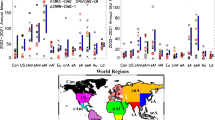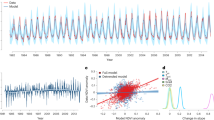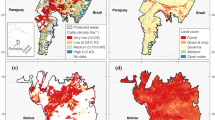Abstract
It is possible that anthropogenic climate change will drive the Earth system into a qualitatively different state1. Although different types of uncertainty limit our capacity to assess this risk2, Earth system scientists are particularly concerned about tipping elements, large-scale components of the Earth system that can be switched into qualitatively different states by small perturbations. Despite growing evidence that tipping elements exist in the climate system1,3, whether large-scale vegetation systems can tip into alternative states is poorly understood4. Here we show that tropical grassland, savanna and forest ecosystems, areas large enough to have powerful impacts on the Earth system, are likely to shift to alternative states. Specifically, we show that increasing atmospheric CO2 concentration will force transitions to vegetation states characterized by higher biomass and/or woody-plant dominance. The timing of these critical transitions varies as a result of between-site variance in the rate of temperature increase, as well as a dependence on stochastic variation in fire severity and rainfall. We further show that the locations of bistable vegetation zones (zones where alternative vegetation states can exist) will shift as climate changes. We conclude that even though large-scale directional regime shifts in terrestrial ecosystems are likely, asynchrony in the timing of these shifts may serve to dampen, but not nullify, the shock that these changes may represent to the Earth system.
This is a preview of subscription content, access via your institution
Access options
Subscribe to this journal
Receive 51 print issues and online access
$199.00 per year
only $3.90 per issue
Buy this article
- Purchase on Springer Link
- Instant access to full article PDF
Prices may be subject to local taxes which are calculated during checkout



Similar content being viewed by others
Change history
08 August 2012
Axis labelling in Fig. 1d was corrected.
References
Lenton, T. M. et al. Tipping elements in the Earth’s climate system. Proc. Natl Acad. Sci. USA 105, 1786–1793 (2008)
Clark, J. S. et al. Ecological forecasts: an emerging imperative. Science 293, 657–660 (2001)
Lenton, T. M. Early warning of climate tipping points. Nature Clim. Change 1, 201–209 (2011)
Scheffer, M., Carpenter, S., Foley, J. A., Folke, C. & Walker, B. Catastrophic shifts in ecosystems. Nature 413, 591–596 (2001)
Carpenter, S. R. et al. Resilience and resistance of a lake phosphorus cycle before and after food web manipulation. Am. Nat. 140, 781–798 (1992)
Scheffer, M. & Carpenter, S. R. Catastrophic regime shifts in ecosystems: linking theory to observation. Trends Ecol. Evol. 18, 648–656 (2003)
Liu, Z., Wang, Y., Gallimore, R., Notaro, M. & Prentice, I. C. On the cause of abrupt vegetation collapse in north Africa during the Holocene: climate variability vs. vegetation feedback. Geophys. Res. Lett. 33, L22709 (2006)
Scheiter, S. & Higgins, S. I. Partitioning of root and shoot competition and the stability of savannas. Am. Nat. 170, 587–601 (2007)
Staver, A. C., Archibald, S. & Levin, S. A. The global extent and determinants of savanna and forest as alternative biome states. Science 334, 230–232 (2011)
Hirota, M., Holmgren, M., Van Nes, E. H. & Scheffer, M. Global resilience of tropical forest and savanna to critical transitions. Science 334, 232–235 (2011)
Walter, H. Ecology of Tropical and Subtropical Vegetation (Oliver & Boyd, 1971)
Cox, P. M. et al. Amazonian forest dieback under climate-carbon cycle projections for the 21st century. Theor. Appl. Climatol. 78, 137–156 (2004)
Malhi, Y. et al. Exploring the likelihood and mechanism of a climate-change-induced dieback of the Amazon rainforest. Proc. Natl Acad. Sci. USA 106, 20610–20615 (2009)
Rammig, A. et al. Estimating the risk of Amazonian forest dieback. New Phytol. 187, 694–706 (2010)
Scholes, R. J. & Archer, S. R. Tree–grass interactions in savannas. Annu. Rev. Ecol. Syst. 28, 517–544 (1997)
Ehleringer, J. R., Cerling, T. E. & Helliker, B. R. C4 photosynthesis, atmospheric CO2 and climate. Oecologia 112, 285–299 (1997)
Bond, W. J. & Midgley, G. F. A proposed CO2-controlled mechanism of woody plant invasion in grasslands and savannas. Glob. Change Biol. 6, 865–869 (2000)
Higgins, S. I., Bond, W. J. & Trollope, W. S. W. Fire, resprouting and variability: a recipe for grass–tree coexistence in savanna. J. Ecol. 88, 213–229 (2000)
Bond, W. J. What limits trees in C4 grasslands and savannas? Annu. Rev. Ecol. Evol. Syst. 39, 641–659 (2008)
Scheiter, S. & Higgins, S. I. Impacts of climate change on the vegetation of Africa: an adaptive dynamic vegetation modelling approach. Glob. Change Biol. 15, 2224–2246 (2009)
Peel, M. C., Finlayson, B. L. & McMahon, T. A. Updated world map of the Köppen–Geiger climate classification. Hydrol. Earth Syst. Sci. 11, 1633–1644 (2007)
Drake, B. G., Gonzalez-Meler, M. A. & Long, S. P. More efficient plants: a consequence of rising atmospheric CO2? Annu. Rev. Plant Physiol. Plant Mol. Biol. 48, 609–639 (1997)
Bowman, D. M. J. S., Murphy, B. P. & Banfai, D. S. Has global environmental change caused monsoon rainforests to expand in the Australian monsoon tropics? Landscape Ecol. 25, 1247–1260 (2010)
Wigley, B. J., Bond, W. J. & Hoffman, M. T. Thicket expansion in a South African savanna under divergent land use: local vs. global drivers? Glob. Change Biol. 16, 964–976 (2010)
Buitenwerf, R., Bond, W. J., Stevens, N. & Trollope, W. S. W. Increased tree densities in South African savannas: >50 years of data suggests CO2 as a driver. Glob. Change Biol. 18, 675–684 (2012)
Kgope, B. S., Bond, W. J. & Midgley, G. F. Growth responses of African savanna trees implicate atmospheric CO2 as a driver of past and current changes in savanna tree cover. Austral Ecol. 35, 451–463 (2010)
Prentice, A. I., Harrison, S. P. & Bartlein, P. J. Global vegetation and terrestrial carbon cycle changes after the last ice age. New Phytol. 189, 988–998 (2011)
Prentice, I. C. et al. in Terrestrial Ecosystems in a Changing World (eds Canadell, J. G., Pataki, D. & Pitelka, L. F. ) 175–192 (Springer, 2007)
Roeckner, E. IPCC DDC AR4 ECHAM5/MPI-OM SRESA1B run1. World Data Center for Climate, CERA-DB ‘EH5 MPI OM SRESA1B 1’ <http://cera-www.dkrz.de/WDCC/ui/Compact.jsp?acronym=EH5_MPI_OM_SRESA1B_1> (2005)
New, M., Lister, D., Hulme, M. & Makin, I. A high-resolution data set of surface climate over global land areas. Clim. Res. 21, 1–25 (2002)
Acknowledgements
We thank D. Bennu and T. Hickler for helping us improve the manuscript. Financial support was provided by the Deutsche Forschungsgemeinschaft and Hesse’s Landes-Offensive zur Entwicklung Wissenschaftlich-ökonomischer Exzellenz (LOEWE) programme.
Author information
Authors and Affiliations
Contributions
S.I.H. and S.S. jointly conceived the study. S.S. ran the simulations. S.I.H. led the writing.
Corresponding author
Ethics declarations
Competing interests
The authors declare no competing financial interests.
Supplementary information
Supplementary Information
This file contains Supplementary Methods, Supplementary Tables 1-2 and additional references. (PDF 195 kb)
Rights and permissions
About this article
Cite this article
Higgins, S., Scheiter, S. Atmospheric CO2 forces abrupt vegetation shifts locally, but not globally. Nature 488, 209–212 (2012). https://doi.org/10.1038/nature11238
Received:
Accepted:
Published:
Issue Date:
DOI: https://doi.org/10.1038/nature11238
Comments
By submitting a comment you agree to abide by our Terms and Community Guidelines. If you find something abusive or that does not comply with our terms or guidelines please flag it as inappropriate.



